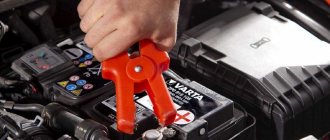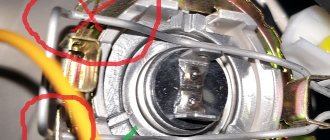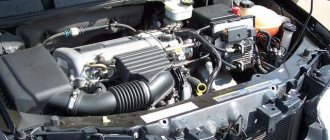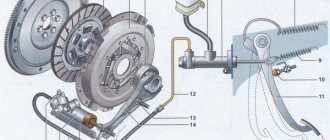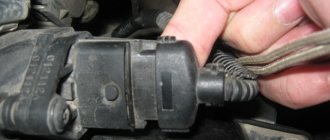Purpose of distilled water
Distilled water is an important component in the liquid of a car battery, ensures its full functionality, maintains the desired density of the electrolyte, which contains 65%. And the percentage of sulfuric acid is only 35%.
Sulfuric acid is a fairly highly concentrated chemical compound that, in its pure form, poses a danger to the battery. To reduce its concentration, purified water is needed. The ratio Н2О/H2SO4 = 65/35 ensures the accumulation of electrical energy at the time of charging the battery, which is subsequently used to start and move the vehicle.
Distilled water (DV) is ordinary water purified from organic compounds (waste products of plants and animals, bacteria, viruses) and inorganic impurities (salts, mineral additives, other substances). It consists of two chemical elements: hydrogen (H) and oxygen (O).
Before you find out how much distilled water to add to the battery, it is important to understand that ordinary water is not suitable for such a procedure. It contains a large number of different impurities (salts, chlorine, lime and others), which contribute to the rapid failure of the car battery. You cannot pour boiled water into the battery, since ordinary boiling does not distill (purify) the liquid in full.
Comparison of distillate and electrolyte
Both mixtures are necessary for the normal functioning of the battery. The distillate is one of the main components of the electrolyte. The electrolyte itself contains, in addition to distilled water (65%), sulfuric acid. Its concentration is 35%.
Both liquids are different in composition. There are no impurities in the distillate. This is a completely purified solution. The electrolyte consists of several components. One of them is sulfates.
Recommendation. If the electrolyte density is normal, then there is no need to use distilled water. But if the concentration of sulfuric acid in the solution becomes high, then it is better to dilute it with distillate.
Why is no electrolyte used?
During the operation of the battery, especially in the summer, the battery heats up, as a result of which the jars may boil. The DW evaporates at this moment. Acid is a non-volatile liquid; accordingly, it remains and the concentration of water decreases. The density of the mixture sometimes increases to 1.4 g/cm3. Therefore, in order to bring the electrolyte to normal density, it is necessary to add DV.
If you pour electrolyte, the density will decrease, but not enough.
It is important to remember about salt precipitation and destruction of the plates. Therefore, in order to reduce the density of the liquid to the established norm, only DV is added. This rule must always be remembered!
It is also worth remembering that water is added only to batteries of the type being serviced, which are characterized by maximum evaporation. Maintenance-free batteries are equipped with a molded sealed case; the evaporated liquid does not come out, it precipitates inside the can. In this case, a closed cycle occurs; there is no need to add water.
We recommend: Features of Korean car batteries
Why can't you add undistilled water?
The purified liquid is obtained by double evaporation and collection of condensate. The result is that it gets rid of foreign salts, minerals and other substances. That is, the output is pure H2O. In the right proportion, sulfuric acid and water create the necessary electrical conductivity of the working mixture.
Condensation after evaporation during operation of a car battery does not leave any residue. Therefore, it can be constantly added to the battery without consequences. That is, deposits will not appear on the electrodes. The presence of impurities can have a detrimental effect on battery performance:
- The appearance of sediment on the plates, due to which they are constantly destroyed, resistance increases and capacity decreases.
- Unpredictable change in electrical conductivity.
- Acceleration of self-discharge due to increased density of the working mixture.
Attention! Distilled water is sold at gas stations and stores. But there are fakes there too. Therefore, even after purchasing the necessary product, you can fill the battery with ordinary water with all the ensuing consequences.
To prevent this from happening, it is enough to check the presence of information about the manufacturer on the label. The most reliable way to measure electrical resistance is with a tester. Without impurities it will tend to infinity, otherwise the device will show a specific number.
When is battery refilling required?
Most experts believe that car batteries do not require maintenance. Accordingly, adding water to it is irrelevant, but provided that the battery is used under normal conditions. It is imperative to check the fluid level for motorists who travel long distances in their own cars. In this case, the probability of converting the liquid into a vapor state is greatest. And also the active process of water evaporation is carried out in the event of failure of the relay regulator.
Main indicators of failure of the relay regulator:
- during the operation of the vehicle, the battery becomes very hot;
- drops of electrolyte are observed on the battery body;
- Strong steam comes out of the filler necks.
It is necessary to take into account the design of the battery. In serviced models, much greater evaporation of H2O occurs. Therefore, it is for them that it is worth knowing how much water to add to the battery. In maintenance-free models, evaporation of liquid into the environment is prevented by a sealed cast housing. Such batteries do not require additional maintenance.
What can you do instead of distillate?
To fill the battery, instead of distilled water, it is permissible to use undistilled water.
But the composition used must be purified.
The distillate contains no salts with other impurities. This composition does not adversely affect the condition of the battery.
Important. Replacing distillate as a battery fluid is acceptable, but only if it is as free of salts as possible.
It is allowed to pour into the electrolyte a purified mixture whose composition is as close as possible to distilled water.
Checking the electrolyte level
The presence of electrolyte is checked exclusively in serviced batteries.
They are most often equipped with a transparent body, so inspection is carried out visually. For this purpose, special marks are made on the surface corresponding to a certain volume of liquid. Serviceable batteries with an opaque casing are also available. To determine to what level to add water to the battery in this case, the vehicle owner will need a special transparent tube with a diameter of 0.5 cm.
Fluid level check sequence:
- The battery cover is unscrewed;
- the transparent tube is lowered into the liquid, and it should rest against the bottom of the jar;
- its outer hole is clamped tightly with a finger;
- it is then removed from the battery to determine the electrolyte level.
Such a tube has minimum and maximum divisions. Accordingly, if the accumulated liquid is within these limits, the volume of electrolyte is normal. If the fluid is below the minimum, you need to add DV.
How to properly pour liquid into the battery
After answering the question of what kind of liquid should be poured into the battery, the following questions arise: how to add water to the battery, and also how much distilled water to add to the battery? Let's look into it in detail.
To what level
There are several ways to check the electrolyte level in the battery. If the case is translucent and the manufacturer has applied special marks to determine the level, you can determine it by placing the battery on a flat surface.
If the case is opaque, the battery is disconnected from the terminals, removed from the car and installed on a flat horizontal surface. Then you need to unscrew the caps of all the cans and measure the level with a special glass tube with marks applied to it. In the absence of such a tube, a plastic case from a transparent ballpoint pen will do.
Measuring the liquid level is simple: lower the tube into the battery jar until it touches the plates. The upper edge of the tube is clamped with your thumb and the tube is removed from the jar. The level is checked using a ruler or pre-applied marks, which should be in the range from 10 to 15 mm.
In some batteries, if you look through the filler neck, you can see the level mark - a plastic tab. In this case, you need to add electrolyte until it reaches this mark.
How to check and equalize density
Hydrometers are used to check the density of the electrolyte. There are two main types of hydrometers used: constant mass hydrometer and float hydrometer.
Constant mass hydrometer
Float hydrometer
For more information about methods of measuring electrolyte density and its dependence on climatic conditions, read the article “how to check electrolyte density.”
The density is checked in all battery banks. If some of the jars have a higher density than the others, then add distilled water. After this, the density decreases. If the density is less than it should be, then you can add electrolyte. And if the density in one of them is too high, and in the other too low, then the electrolyte can be poured from jar to jar using the same hydrometer, leveling out the density. The point is that by adding water or electrolyte, you achieve the desired and identical density in each jar.
Density measurements should be carried out at an air temperature of +25°C.
How much water should be added
With modern batteries it is easier to figure out how much DV to add to the system. Their body is often made of transparent plastic, on which the liquid volume scale is broken. You just need to visually monitor its level in the system. It should not be less or more than the permissible norm.
We recommend: Lead-acid batteries for Daewoo Nexia: parameters and polarity
Recommendations on how to add distilled water to a battery of a different design are as follows:
- Some battery models have a plastic (metal) “tongue” slightly below the neck of the can. It is necessary to fill the liquid 0.5 cm above it.
- If there are no marks in the jar, add water 1.5 cm above the lead plates.
- If it is impossible to visually determine the presence of electrolyte in the battery, then it is recommended to use a specialized glass tube with a scale.
It is important to correctly top up the electrolyte so that the density of the electrolyte meets the established standards. At higher concentrations, hydrochloric acid will destroy lead plates.
If it is deficient, you can defrost a car battery at significant sub-zero temperatures.
Proper battery maintenance
Currently, the industry mainly produces low-maintenance batteries for cars; they require a minimum of care, however, preventive maintenance must be carried out regularly. To service the battery, you must:
- Remove the battery from the car:
- take it to a warm room;
- clean the housing from dirt and salt deposits (do not turn the housing over);
- clean the terminals from deposits with sandpaper; if they are oxidized, wipe dry with a clean rag;
- let it sit for 10-12 hours (you can do it for a day; it is especially important to let the battery “dead” in winter).
Then you should check the electrolyte level in the jars, add distilled water if necessary, and charge the battery. You can’t do without a charger, just like you can’t do without a hydrometer, and it would also be nice to have a multimeter and a load plug. After the battery has settled, we check the voltage without load with a multimeter; it should be in the range of 12.4-12.7 Volts. When connected to the terminals of the load plug, the voltage should not fall below 9.6 V, the load lasts about 5 seconds.
After adding water to the required level, we check the density with a hydrometer; in those jars where we had to add more, the density will be lower accordingly. Then we place the plugs in their places without tightening them, connect the charger to the terminals, if the battery is in fairly good condition, automatic mode is suitable for charging.
The battery is charged most efficiently at room temperature +20ºC; after charging, it is again necessary to let the battery sit, but 5-7 hours is enough. Then we repeat all the checks again, the most optimal values are:
- voltage without load – 12.7 Volts (up to 13.0 V);
- under load – from 9.6 to 10.4 V;
- density – 1.27-1.28 g/cm³.
For northern regions, the electrolyte density can be set higher (up to a value of 1.31); for southern regions, 1.26 g/cm³ is often sufficient.
Depending on the type of battery, it is recommended to carry out battery maintenance once or twice a year; low-antimony batteries require maintenance more often, approximately once every 3 months. Video: Water or electrolyte, what should I add to the battery?
Related articles:
- Features of VAZ-classic rear axle gearboxes All VAZ-classic cars are rear-wheel drive, the vehicle moves using the rear axle, which is the drive axle. The VAZ rear axle gearbox is the most important part in the transmission, [...]
- Disabling the front passenger airbag Drivers are often interested in how to disable the passenger airbag; this article will be devoted to this topic. Modern passenger cars are equipped with several [...]
- Which gasoline is better to refuel with, 92 or 95? In the article we will look at what to do if you fill up with low-quality gasoline, why it is necessary to fill your car with fuel that meets the technical […]
How to add fluid correctly
If the density of the electrolyte in a car battery has increased or the battery does not provide the required voltage, then the reason is evaporation of the active substance. According to the norm, the electrolyte consists of: H2SO4 (sulfuric acid) - 35%; H2O - 65%.
Instructions for adding fluid to the battery:
- The upper surface of the battery is cleaned of dirt and thoroughly wiped, especially near the plugs.
- While charging the battery, sulfuric acid may have splashed out. Therefore, to neutralize it, the neck area must be wiped with a rag soaked in a soda solution.
- Now you need to carefully unscrew the plugs. It is recommended to wear gloves to protect your hands from the electrolyte.
- Using a medical syringe, DV is drawn up and poured into jars where the liquid level has dropped.
- The plugs are screwed in.
- After 2 hours, it is necessary to check compliance with the electrolyte density standards using a special device - a hydrometer. If the indicators are normal, the battery can be charged.
Add liquid only on a horizontal surface, otherwise the level will show the wrong volume. It is also worth considering the fact that the density of the electrolyte differs in different climatic conditions. For example, in Russia:
- in the south of the country - 1.25 g/cm3;
- in the central regions - 1.27 g/cm3;
- in the northern territories - 1.29 g/cm3.
We recommend: Maintenance-free car battery: device, battery models
To accurately measure the density of a liquid, the hydrometer must be strictly in a free state, in a vertical position and not in contact with the walls of the container. Having carefully lowered the hydrometer into the liquid, you need to wait until it completely stops oscillating, then take readings on the scale at the point of its intersection with the surface of the electrolyte. This is the density of the liquid.
How much distilled water should be added to the battery and how to do it correctly
If your battery is maintenance-free, you do not need to carry out any manipulations with liquids. A serviced lead-acid system will need to periodically add water. In order to determine how much liquid to add, you need to remove the top caps from the battery cans and check the density of the battery and the electrolyte level in each of the containers.
The amount of water that should be poured into the battery may vary, depending on its capacity and the operating conditions of the battery. It is worth thinking about how to add distilled water to the battery at any time, because the liquid level may become lower at the most inopportune moment. To do this, it doesn’t hurt to always have a suitable container for water in your car, for example, a liter bottle, and you can always add water. Do not allow the battery plates to become exposed - they will quickly crumble as a result of heating.
The algorithm for how to properly fill a battery with water at home is simple:
- Disconnect the battery from the vehicle's on-board network . Take it out of the car.
- Make sure that the surface on which it will be placed is level .
- Clean the battery from dust and dirt . You can do this with a soda solution.
- For maximum accuracy, use a disposable syringe . And for your own safety , wear technical gloves that you usually use for gardening or cleaning.
- Remove the battery caps to access the jars.
- Check the liquid level inside each can . Remember that normally the electrolyte should cover the battery plates by 1-1.5 cm.
- If the coating level of the plates is less, add 5 to 10 ml of distilled water to each battery compartment .
- If it turns out that the syringe has “overfilled”, simply suck out the excess liquid with a small rubber bulb to the desired level .
Below are some more tips regarding battery operation. This information will be useful if you do not know how to add water to the battery correctly:
- You cannot add fluid to the battery if you have just turned off the internal combustion engine . Let the battery “stand” for 7-8 hours (preferably at home). Only then open the battery.
- Also, after the battery is filled with distilled water, you cannot immediately start the engine .
- The waiting time after filling is until the next morning . Otherwise, the battery may immediately boil and the plates may crumble.
- Remember that the “country” version of the room used for filling the battery can only be used in the warm season . If the room is not heated, you should not perform such actions with the battery.
- It is important to know that using distilled water will not return the battery to its previous capacity , but will improve its performance for a certain period.
- Before starting the engine, always check the electrolyte level in the battery , keeping in mind the quantitative indicators.
This is interesting: Lessons from survival school: how to charge your phone battery without a phone
Obtaining distillate at home
There are motorists who do not go to the store for DV.
They produce it themselves at home. This is mainly the older generation, who lived through times of shortage, and people living in settlements remote from the city, where many products simply do not arrive. If you want to prepare DV yourself, you should understand that it will not be of high quality, since for this you need to have special expensive equipment - a distiller. But as an alternative, a regular moonshine still without a coil is suitable. The productivity of the DV when using this option will be approximately 1 glass in 3-4 hours.
The formula of distilled water is H2O. A high-quality liquid should not contain foreign impurities. It is impossible to achieve such a result under domestic conditions; a small content of metal salts will still remain.
Recommendations:
- If you urgently need to add water to the battery, you can take it from the tap into a plastic bottle and put it in the freezer for 2-3 hours. You should only use ice that has been melted beforehand. Unfrozen water is drained into the sink. The DV obtained in this way will cause minimal damage to the battery.
- Another way is to collect rainwater in a plastic container, carefully filter it, and then use it for its intended purpose.
Important! The collected water for the battery should not come into contact with iron objects. For example, water running off the metal roof of a house is not suitable for this purpose.
Just add water: how to revive a dead battery
Serviced or not?
The electrolyte of lead batteries consists of two components - sulfuric acid and water.
Water, which evaporates over time, is to blame for the decrease in electrolyte levels. As a result, some of the plates are not immersed in the electrolyte, and the battery loses capacity. If in summer this effect can be ignored painlessly, in winter it will certainly give you a frosty morning pig... It is customary for car owners to divide batteries into “maintenance” and “non-maintenance” according to the type of caps on banks. If the plugs are present and can be unscrewed with a coin, it means it is “serviceable”: you need to monitor the electrolyte level and add water if necessary. If there are no traffic jams, it’s the other way around.
Articles / Practice Light a cigarette - throw away the battery: myths and truth about batteries in winter Winter has arrived, and with it traditional battery problems. Both advanced car enthusiasts and lazy drivers are faced with them: cars with open hoods are waiting for a “light”,... 110045 10 12 12.22.2016
- In fact, “maintenance-free” lies primarily in the fact that the battery is made with calcium additives in the lead electrodes instead of the good old antimony, which has been used for decades, says Alexander Kazunin, head of the battery laboratory of the Research Institute of Automotive Electronics and Electrical Equipment.
- “Calcium” batteries have a very low rate of electrolysis of water, which almost does not evaporate from the electrolyte under normal operating conditions. And therefore, they often lack plugs to control the electrolyte level. However, you need to understand that with the advent of “calcium” batteries, the problem of electrolyte boiling away did not completely disappear. “Antimy” batteries, which are prone to a drop in the electrolyte level, are still produced and sold, and “calcium” batteries can easily require monitoring and topping up if the car is driven intensively in the summer in the city cycle or, say, the voltage regulator in the generator is faulty.
Calcium can be applied only to the negative electrodes of the battery or to all electrodes. Batteries in which all electrodes are doped with calcium are called “calcium-calcium” (Ca/Ca). True, the price to pay for the lack of maintenance of the electrolyte level is increased sensitivity to deep discharge. A “calcium” battery, once set to “zero”, as a rule, does not last long...
About water
Often, even in truly maintenance-free batteries, there are still plugs, but they are not separate, but attached to a common plastic plate, which is covered with a branded sticker on top. There are no obvious signs on these plugs that they can be opened. But this can be done, and often necessary. Because the electrolyte level can drop in almost any type of battery.
Leveling a low electrolyte level in a battery is easy and inexpensive. It is enough to purchase a bottle of distilled water from a car store and add it using a syringe or bulb to each battery jar, the number of which is six for a car with a 12-volt electrical system. Looking into the jars with a flashlight, you can see the plas, which is a level mark. If it is not there, water is added until the plates are completely covered. After this, it is highly advisable not to load the battery with the starter, but to recharge it.
Articles / Practice We charge a dead battery in 10 minutes: experiment Kolesa.ru Many of those who are not shy about getting into the “guts” of their car with tools know in practice about a very curious, useful, but at the same time strange and poorly explained... 237773 9 62 04/18/2016
This procedure is simple and accessible to any car owner. The only bottleneck in this story is the purchase of distilled water. Typically, the “distillation” packaged in 1.5-liter bottles is produced by companies like “Horns and Hooves,” and it is not so easy to find water produced by a well-known brand of automotive chemicals on sale. And in view of the low retail and even lower purchase price of distilled water, manufacturers have a serious temptation to reduce costs as much as possible and start dispensing tap water under the guise of distillation for batteries... Moreover, a deceived buyer is unlikely to make a claim: the battery is from ordinary water, will certainly die, but this will not happen instantly.
Here is a typical review of low-quality distilled water from one of the UAZBUKI forum members:
“Once I had an unopened bottle of this water lying in my trunk. She probably lay there for four months. And somehow I decided to add it to the cooling system. I opened the bottle and it smelled like rotten stuff - at least run away. What swamp did they get it from..."
TDS meter
You can check the quality of purchased distilled water using different methods. The most correct way of checking available at home is to use a specialized device called a TDS meter. Chinese online stores are full of them, they are not too expensive, and the accuracy is quite sufficient for our needs. The TDS meter looks like a pencil with a display and measures the level of total mineralization (salt content) of water in “ppm” units - the number of particles of dissolved salts per million particles of an aqueous solution.
We measure tap water - 215 ppm. We measure distilled water from a car store - a bottle from one manufacturer shows 8 ppm, a second – 7 ppm, and a third, the one that says “double purification”, shows 0 ppm!
Respect to the last manufacturer, of course! The product is really high quality. But even if the ppm of distillation is not zero, there is no need to worry. A small number is within acceptable limits. In the end, almost any Soviet textbook on automotive operating materials, as a last resort, allowed the use of melted snow water for the electrolyte (not from city snowdrifts, of course), the ppm of which is usually 10-20.
1 / 4
2 / 4
3 / 4
4 / 4
Ohmmeter
Many sources suggest checking the quality of distilled water with a multimeter in ohmmeter mode. In other words, simply by measuring its resistance. Often there are even numbers: if the water resistance is more than 30 kilo-ohms, this means the water is suitable for the battery.
At first glance, it looks reasonable: a multimeter, unlike a TDS meter, is found at home or in the garage much more often than the latter. And the TDS meter calculates the number of ppm indirectly, precisely through measuring the water resistance.
But there is a fundamental difference: a TDS meter measures resistance on alternating current, and an ohmmeter measures resistance on direct current. And electrochemical processes that begin in water when direct current is passed introduce very large errors. And when we add to them the completely random geometric dimensions of the ohmmeter’s measuring electrodes, and the distance between them, taken by eye, the parameters begin to jump chaotically, changing tens of times. So you shouldn’t use a multimeter to assess the quality of the distillate.
Evaporation
The next method is visual. It is unlikely to give a clear assessment of the quality of the “distillation”, but at least it will allow you to identify outright fraud when, under the guise of demineralized water, they slip you tap water.
For this test we need a clean piece of glass. We drop two drops of water on it next to each other: what we consider to be distilled, and tap water for clarity. Then we wait for the water to evaporate, which can be accelerated by heating the glass on the lighter. After evaporation, distilled water leaves virtually no salt stains, the stain simply disappears. If obvious salt “circles” are noticeable, the water is most likely from the tap...
In the photo on the left there is a salt stain from tap water, on the right nothing is visible - a drop of distilled water has evaporated there.
220 volt
And finally, one more way. Severe Chelyabinsk - checking water resistance on an alternating current electrical network of 220 volts. As it becomes clear, it is based on the fact that ordinary water conducts electric current, while distilled water practically does not. This is also a conditional test that does not give results in digital form, but is quite suitable for everyday use, and most importantly, it is visual. The procedure is quite simple, but requires some caution when handling exposed live wires!
We assemble a simple circuit from an electrical cord with a plug and a socket for a 220-volt incandescent lamp. Approximately in the middle of the double cord, cut one of the wires and strip the ends. Now the cut ends serve only as a breaker. We screw in the lamp, insert the plug into the socket for testing - the lamp burns at full intensity. Now we take out the plug, cut one of the wires of the pair, strip both ends to a length of about a centimeter each and lower these ends into a glass of test water. Re-insert the plug into the socket. The lamp will not burn on distilled water, but on tap water its filament will glow dimly, dimly, at less than a quarter of the incandescence.
Well, now that it is clear which water is truly distilled and which is not, the only thing left to do is add the “correct” water to the battery. And in the same way as we described above. And enjoy the good battery performance.
Survey
What do you do if the battery does not spin well?
Your voice
Total votes:
